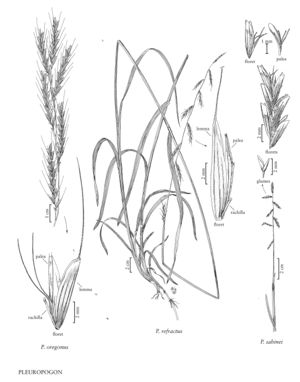Pleuropogon refractus
Plants perennial; not cespitose, rhizomatous. Culms (85)100-150 cm, erect. Sheaths glabrous or pubescent, sometimes scabrid¬ulous; ligules 2-7 mm; blades 10-40 cm long, 5-14 mm wide, apices acute or acuminate and sharply mucronate, flag leaves often reduced to spinose tips. Racemes (10)20-35 cm, with 6-14 spikelets; internodes 2-5.6(8) cm; pedicels 2-3 mm long, reflexed at maturity. Spikelets (20)25-28 mm, pendent, with 7-14 florets, usually all but the terminal floret bisexual. Glumes frequently scabrous, apices obtuse, sometimes erosely notched; lower glumes 3-6 mm; upper glumes 4-7(8.3) mm, 3-veined; rachilla internodes 2-3 mm long, about 0.1 mm thick, bases sometimes weakly differentiated into a glandular swelling; lemmas 8-10 mm, faintly 7(9)-veined, lateral veins occasionally prominent, apices truncate, sometimes toothed, awned, awns (5)9-20 mm; paleal keels each with a 0.2-0.6(1) mm triangular appendage; anthers 3.5-4 mm. Caryopses 4.5-6 mm. 2n =32, 36.
Distribution
Calif., Oreg., Wash., B.C.
Discussion
Pleuropogon refractus grows in wet meadows, riverbanks, and shady places, from sea level to about 1000 m. Its range extends from British Columbia south to California.
Selected References
None.
